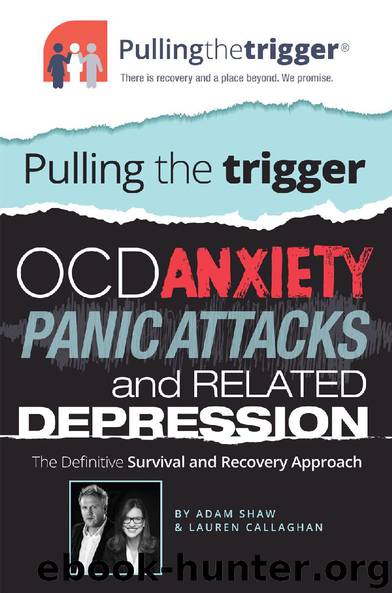Pulling the trigger by Adam Shaw & Lauren Callaghan

Author:Adam Shaw & Lauren Callaghan
Language: eng
Format: epub
ISBN: 9781911246008
Publisher: Trigger Press Ltd
Published: 2016-03-15T00:00:00+00:00
Accepting our thoughts and our feelings can feel very uncomfortable and counter-intuitive to some extent. When things feel uncomfortable or distressing, our first instinct is to solve or avoid the problem, and this message is reinforced by everyday living. Think of all the advertisements you are bombarded with on a daily basis – if you have a physical pain, fix it with a pill; if you have hair loss, fix it with this treatment ... and so on. However, this does not work in anxiety, as we have seen. So it is important to know that however uncomfortable your thoughts or feelings are, they are not permanent. They will not last forever, and will change hour by hour, day by day, week by week. Think of how you felt when you woke up this morning. I guarantee that you will be feeling differently by this evening (it could be you feel worse or better than this morning), but the point is that it will be different from how you were feeling this morning, whether a different feeling or different intensity of the same feeling. All thoughts and all feelings are impermanent and do not last forever, and they will change over time.
In Section 2 of the PTT approach ( Embrace ) we will look at ways of challenging unhelpful thoughts and interpretations to help you see that anxiety is almost never based on reality.
SUMMARY
Lauren: In this section we’ll recap everything we’ve learned so far about anxiety-based illnesses, then Adam will add his conclusion about accepting anxiety. We know there is a lot to take in, and while our PTT approach is essentially not a complicated one, there are building blocks to understand and accept your anxiety problem before we move on to the next, more practical stage of our treatment approach.
Remember, anxiety and fear are less of a problem and more of a human condition that applies to everyone. Fear is the emotional reaction to real or perceived imminent danger. Anxiety is a response to what we anticipate as a threat, and these can be very useful responses in the right situation. Remember the example we gave about the dog running towards you, and the ‘fight, flight or freeze’ mechanism. Panic attacks are an acute experience of fear and anxiety responses, and happen across all anxiety and obsessional disorders.
Threats are not just about large dogs. They can be about redundancy, divorce, death, loss, illness and everything else we see as a challenge to everyday existence. But threats only become a problem when we seem to be mismanaging them. This is all down to whether we interpret the event, situation or thought as a highly likely or probable threat and seek to remove any likelihood of it happening in the future.
For example, many people accept death as an inevitable part of life. While they’d rather it didn’t happen to them, they know that one day it will. Others, however, see death as the biggest threat in life, and do everything to avoid it (and by doing so, ironically don’t really live life as they should.
Download
This site does not store any files on its server. We only index and link to content provided by other sites. Please contact the content providers to delete copyright contents if any and email us, we'll remove relevant links or contents immediately.
Should I Stay or Should I Go? by Ramani Durvasula(6821)
Why We Sleep: Unlocking the Power of Sleep and Dreams by Matthew Walker(5676)
Fear by Osho(4104)
Flow by Mihaly Csikszentmihalyi(4075)
Rising Strong by Brene Brown(3796)
Why We Sleep by Matthew Walker(3794)
Too Much and Not the Mood by Durga Chew-Bose(3707)
How to Change Your Mind by Michael Pollan(3695)
The Hacking of the American Mind by Robert H. Lustig(3594)
Lost Connections by Johann Hari(3463)
He's Just Not That Into You by Greg Behrendt & Liz Tuccillo(3321)
Evolve Your Brain by Joe Dispenza(3068)
What If This Were Enough? by Heather Havrilesky(2952)
Resisting Happiness by Matthew Kelly(2896)
Crazy Is My Superpower by A.J. Mendez Brooks(2875)
The Courage to Be Disliked by Ichiro Kishimi & Fumitake Koga(2817)
The Book of Human Emotions by Tiffany Watt Smith(2785)
Descartes' Error by Antonio Damasio(2755)
In Cold Blood by Truman Capote(2698)
